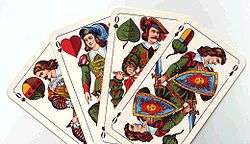Elfern
| "A primitive German game akin to Bohemian Schneider."[1] | |
 A picture of four Obers of German cards
| |
| Origin | Germany |
|---|---|
| Type | Trick-taking |
| Players | 2 |
| Cards | 32 |
| Deck | German or French |
| Play | Alternate |
| Card rank (highest first) | D K O U 10 9 8 7 |
| Related games | |
| Bohemian Schneider | |
Elfern, also known as Figurenspiel or Elfmandeln, is a German and Austrian 6-card no-trumps trick-and-draw game for two players using a 32-card piquet pack. The object is to win the majority of the 20 honours ace, king, queen, jack and ten.
Rules
| Rank | A | K | Q | J | 10 | 9 | 8 | 7 |
|---|---|---|---|---|---|---|---|---|
| Value | 1 | – | ||||||
Every player receives a hand of 6 cards in batches of 2. There are no trumps, and tens rank low in trick-play. Elder hand leads to the first trick. A trick is won by the player of the highest card of the suit led. In the first phase of the game, the winner of a trick draws a card from the stock, followed by the other player, before leading to the next trick. Players need not follow suit in this phase.[2]
The second phase begins as soon as the stock is depleted. In the second phase players use up their hand cards and must follow suit, as revoking can now be proved in all cases.[2]
Except for ranks 7–9, which are worthless, every card is worth one card-point for a total of 20. The deal is won with a score of 11 or more, won double (opponent is schneider, tailor) with a score of 15 or more, and won triple (opponent is schwarz, black) with a score of 20.[2]
The winner becomes dealer in the next game. If the game is tied (both players won 10 card-points, a Ständer), it is held in abeyance, i.e. the winner of the next game wins both. In this case the dealer for the next game is decided by random.[2][3]
Variations
| Rank | A | 10 | K | Q | J | 9 | 8 | 7 |
|---|---|---|---|---|---|---|---|---|
| Value | 11 | 10 | 4 | 3 | 2 | – | ||
- The game can be played with a fixed or random trump suit. If played with trumps, a player who cannot follow suit must trump.
- The seven beats the ace of the same suit.
- Cards are beaten by the next higher rank, regardless of suit.
- 16 is required for a double win. Or the following schedule is used: 11–13 honours 1 point, 14–15 honours 2 points, 16–17 honours 3 points, 18–19 honours 4 points, 20 honour 5 points.[4]
- In case of a tie, the next game counts double, but the game after two ties does not count quadruple.[4]
- The card-point values typical for Ace-Ten card games can be used. In this case tens rank high, 61–90 card-points win the game, 91–119 win it double, and 120 win it triple.
- The game can be played with hands of less than 6 cards,[2] but then it becomes more random.[3]
- Players must win the trick if possible.[3]
History and Etymology
Elfern is German for making eleven, and Elfmandeln is Austrian German for eleven little men. Thus both names refer to the score of 11 points required for winning. Figurenspiel is also German and can be roughly translated as honours game. This name evidently refers to the fact that only the court cards plus aces and tens contribute to the score. Schneider is German for tailor, a designation generally used in German point-trick games for players who make less than half the normal winning score.
Although the game was first mentioned in the 19th century, David Parlett suggests that its non-trump nature points to its being much older and possibly ancestral to Ace–Ten card games or more specifically King–Queen card games.
References
- ↑ Parlett, David. The Penguin Book of Card Games. London: Penguin (2008). p. 255. ISBN 978-0-141-03787-5.
- 1 2 3 4 5 Abenstein, G.W. von (1820), Neuester Spielalmanach (in German) (2nd ed.), Berlin: Hayn .
- 1 2 3 Alvensleben, Ludwig von (1853), Encyklopädie der Spiele (in German), Leipzig: Otto Wigand .
- 1 2
- Erweitertes Spielregelbüchlein aus Altenburg (in German) (8th ed.), Altenburg: Altenburger Spielkartenfabrik, 1988 .